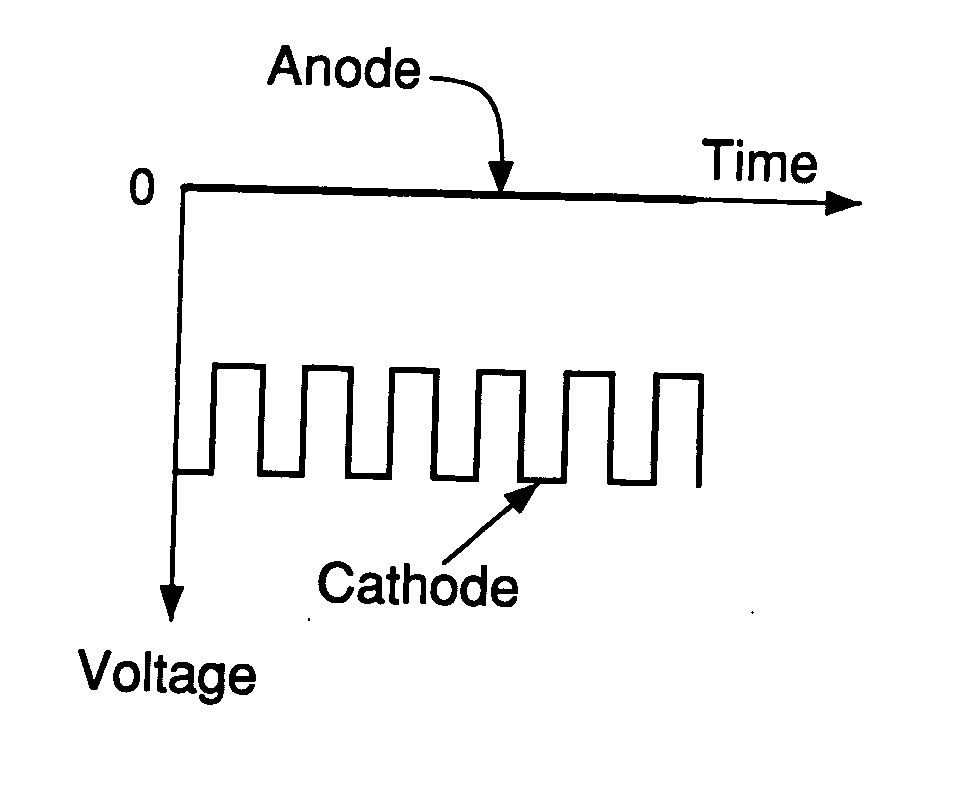Apparatus and method for removal of surface oxides via fluxless technique involving electron attachment and remote ion generation
a fluxless and surface oxide technology, applied in the direction of chemistry apparatus and processes, solventing apparatus, manufacturing tools, etc., can solve the problems of forming voids in the solder joints, corrosion and electric shorts, contaminating the reflow furnace, etc., and achieve the effect of reducing oxides
- Summary
- Abstract
- Description
- Claims
- Application Information
AI Technical Summary
Benefits of technology
Problems solved by technology
Method used
Image
Examples
example 1
[0071] A first experiment was conducted by using a lab-scale, tube furnace having a downward-facing metal rod with a sharp tip (see FIG. 2b for cathode geometry) inserted near the center of the furnace. The sample used was a fluxless tin-lead solder preform (m.p. 183° C.) on a grounded copper plate (anode), which was loaded inside a furnace and heated up to 250° C. under a gas flow of 5% H2 in N2. When the sample temperature was at equilibrium, a DC voltage was applied between the negative electrode (cathode) and the grounded sample (anode) and gradually increased to about −2 kV with a current of 0.3 mA. The distance between the two electrodes was about 1 cm. The pressure was ambient, atmospheric pressure.
[0072] It was found that the solder was well wetted on the copper surface. Without applying an electric voltage, a good wetting of a fluxless solder on a copper surface can never be achieved at such low temperature, even in pure H2, because the effective temperature for pure H2 to...
example 2
[0074] Several cathode materials were investigated for electron-attachment assisted hydrogen fluxless soldering by using the field emission mechanism using the same set-up as Example 1. The results of the investigation is provided in Table I.
[0075] As Table I illustrates, the best result was obtained by using Ni / Cr cathode, which provided the highest fluxing efficiency and thus resulted in the shortest wetting time. A possible reason is that the Ni / Cr cathode generates a relatively larger quantity of electrons and has a suitable energy level of electrons compared to other cathode materials.
TABLE IEffect of Cathode Material on Wetting Time at 250° C. and 20% H2Material of Cathode RodWith a Sharp Tip( 1 / 16″ dia.)Time to Complete WettingBrass1min 55 secCopper1min 44 secNickel Chromium39secAluminum1min 28 secStainless Steal1minTungsten1min 54 sec
example 3
[0076] In order to demonstrate the feasibility of the electron-attachment assisted H2 fluxless soldering using a remote ion generator, an experiment was conducted wherein a remote ion generator was made using a downward-facing Ni / Cr cathode rod with a sharp tip. The anode consisted of a copper plate covered by a ceramic layer. The electric field applied between the two electrodes was about 2 KV / cm. The remote ion generator was set in front of a test sample, or in other words, toward the gas inlet of the furnace. The distance between the remote ion generator and the test sample was about 2 to 4 cm. The test sample consisting of a Sn / Pb solder perform (m.p. 183° C.) on a copper plate was grounded. When the furnace loaded with the remote ion generator and the test sample was purged with a gas mixture of H2 and N2 (˜5% H2 by volume) and heated up, it was found that at around 220° C., the solder started to wet on the copper.
PUM
| Property | Measurement | Unit |
|---|---|---|
| voltage | aaaaa | aaaaa |
| distance | aaaaa | aaaaa |
| distance | aaaaa | aaaaa |
Abstract
Description
Claims
Application Information
 Login to View More
Login to View More - R&D
- Intellectual Property
- Life Sciences
- Materials
- Tech Scout
- Unparalleled Data Quality
- Higher Quality Content
- 60% Fewer Hallucinations
Browse by: Latest US Patents, China's latest patents, Technical Efficacy Thesaurus, Application Domain, Technology Topic, Popular Technical Reports.
© 2025 PatSnap. All rights reserved.Legal|Privacy policy|Modern Slavery Act Transparency Statement|Sitemap|About US| Contact US: help@patsnap.com



